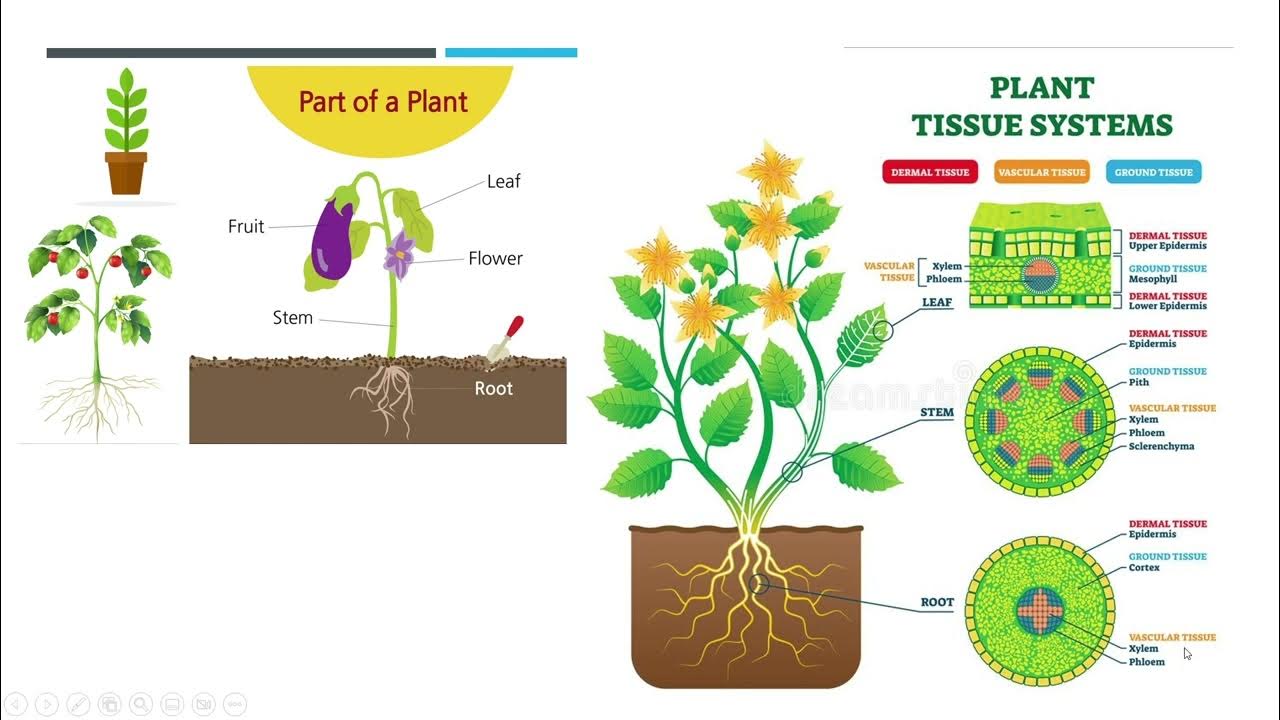Types of Plant Tissues
Summary
TLDRThis script delves into the organization of plant cells into tissues and larger structures, highlighting three main tissue types: ground, dermal, and vascular. Ground tissue, with its subtypes parenchyma, collenchyma, and sclerenchyma, forms the majority of the plant body and is involved in photosynthesis and structural support. Dermal tissue, including the epidermis and stomata, serves as the plant's protective 'skin.' Vascular tissue, differentiated into xylem and phloem, is essential for nutrient and water transport in larger plants, illustrating the complex yet efficient system of plant life.
Takeaways
- 🌿 Cells are the basic unit of life in both plants and animals, organized into tissues, which in turn form organs.
- 🌱 Plants have three primary types of tissues: ground tissue, dermal tissue, and vascular tissue, each with specific functions.
- 🍃 Ground tissue is the most abundant in plants and includes parenchyma, collenchyma, and sclerenchyma, serving various roles like photosynthesis and storage.
- 🌞 Ground parenchyma tissue is crucial for photosynthesis in the mesophyll of leaves and stores excess energy as starches.
- 🛡️ Collenchyma and sclerenchyma tissues provide structural support due to their thick cell walls made of cellulose and lignin.
- 🌳 Dermal tissue forms the 'skin' of the plant, protecting the internal tissues and preventing water loss and pathogen invasion through the cuticle.
- 🌬 Stomata are openings in the epidermis for gas exchange, regulated by guard cells to prevent water loss and pathogen entry.
- 🏵 Epidermal cells can specialize into hairs for specific functions and may deter herbivores.
- 🌾 Vascular tissue is unique to vascular plants and is essential for nutrient and water transport, enabling growth in various environments.
- 💧 Xylem, part of vascular tissue, transports water and minerals upwards in the plant and is involved in transpiration.
- 🍬 Phloem, the other part of vascular tissue, transports sugars produced in leaves to other parts of the plant using companion and sieve cells.
Q & A
What are the three main levels of organization in living organisms?
-The three main levels of organization in living organisms are cells, tissues, and organs.
How do plant cells organize into larger structures?
-Plant cells organize into larger structures by forming tissues, which are then organized into organs.
What are the three main types of plant tissues?
-The three main types of plant tissues are ground tissue, dermal tissue, and vascular tissue.
What is the primary function of parenchyma tissue in plants?
-Parenchyma tissue is responsible for photosynthesis in the mesophyll of leaves, gas exchange, and storage of excess energy in the form of starches.
What is the role of collenchyma and sclerenchyma cells in plants?
-Collenchyma and sclerenchyma cells have thick cell walls made of cellulose and lignin, providing structural support to the plant.
What is the function of the epidermis in plants?
-The epidermis acts as a protective layer for the plant, shielding the more important tissues beneath and secreting a waxy substance called cuticle to prevent water loss and pathogen invasion.
What are stomata and why are they important for plants?
-Stomata are openings in the epidermis that allow water and gases to travel in and out of the plant for material exchange. They are important for maximizing surface area available for this exchange and are regulated by guard cells to prevent pathogen infiltration.
What is the periderm and how does it differ from the epidermis?
-The periderm is a thicker layer of dead cells that replaces the epidermis in older sections of a plant, providing greater protection but being less active and allowing only limited gas exchange.
How does vascular tissue differ from nonvascular tissue in plants?
-Vascular tissue, present in vascular plants like trees, is responsible for redistributing water and nutrients throughout the plant's body, allowing for growth strategies not possible in nonvascular plants like mosses.
What are the two types of vascular tissue and their functions?
-The two types of vascular tissue are xylem, which transports water and mineral nutrients upwards, and phloem, which transports sugars produced through photosynthesis to other parts of the plant.
How do xylem and phloem function together in a plant?
-Xylem and phloem function together similarly to arteries and veins in animals, with xylem transporting water and minerals upwards and phloem transporting sugars downwards, allowing for the distribution of essential substances to all cells in the plant.
Outlines

This section is available to paid users only. Please upgrade to access this part.
Upgrade NowMindmap

This section is available to paid users only. Please upgrade to access this part.
Upgrade NowKeywords

This section is available to paid users only. Please upgrade to access this part.
Upgrade NowHighlights

This section is available to paid users only. Please upgrade to access this part.
Upgrade NowTranscripts

This section is available to paid users only. Please upgrade to access this part.
Upgrade NowBrowse More Related Video

Organization of Plant Body

What Do These Creepy Plant Mouths Do? (Plant Tissues): Crash Course Botany #4

Module 6: Cell Modifications- General Biology I

Types of plant tissues, What are plant tissues and functions, What is tissues in plants

5 vwo | Planten | 1 | Bouw, groei en ontwikkeling van planten

Histology of Connective Tissue #usmle #neetpg #fmge #mbbs
5.0 / 5 (0 votes)